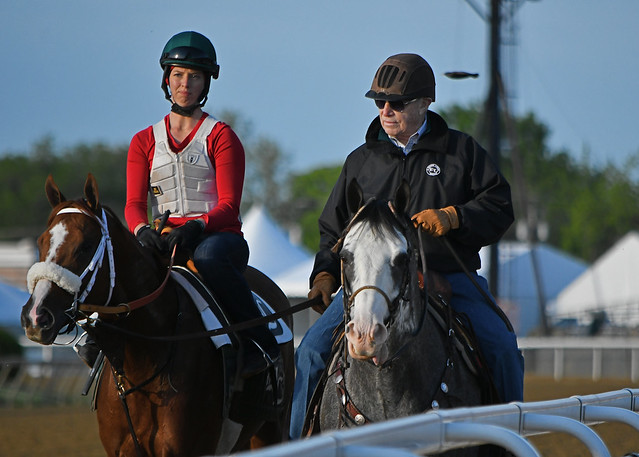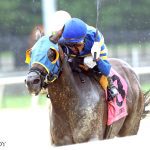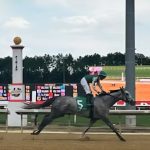Lukas: Fillies “go to the well for you”
Forty-two years ago, D. Wayne Lukas began his Triple Crown career by beating a filly in the Preakness. Now at 86, with a filly of his own, he’s trying to win a record-tying seventh Preakness.
In 1980 Codex, trained by “the Coach,” beat Kentucky Derby-winning filly Genuine Risk in the Preakness, a race that was decided three times: once by the horses on the track, once by the stewards, and a third time by the Maryland Racing Commission. The contested Preakness became a case study of interference (or not) by jockey Angel Cordero.
- Spa Selections 2025: Saratoga Picks July 13
 Picks and analysis for today’s key races from Saratoga.
Picks and analysis for today’s key races from Saratoga.
On Saturday, it’s Lukas with the Preakness sweetheart Secret Oath in the middle gem of the Triple Crown looking to stay one step ahead of the colts. Absolutes are rare when it comes to training horses, but Lukas has picked up on several tendencies in his decades of training fillies. His philosophy on pacing fillies in the Triple Crown may not necessarily be ladies first, but Lukas doesn’t want any part in being last.
“I think you have to have a filly that has the ability to get into the race somewhere between the 3/8ths pole and the wire,” Lukas conveys. “I don’t think you can come from left field as they say. I don’t think you can make one of those killer moves that sometimes a colt will.”
In 1988, Lukas won the Kentucky Derby with the filly Winning Colors on the front end for owner Eugene Klein. Gary Stevens sent the co-favorite out to the lead out of the gate and Winning Colors held off a charging Forty Niner to win by a neck in 2:02 1/5.
What fillies may lack in deep-closing abilities, they may gain in heart, Lukas believes, something that Secret Oath demonstrated in winning the Kentucky Oaks two weeks ago by two lengths. Should the Preakness stretch run result in a dual, Lukas believes he may have an edge.
“I think they go to the well for you, where a colt might protect themselves a little more,” explained Lukas. “A colt is a little more interested in himself, where a filly will definitely go to the well.”
Think Swiss Skydiver stubbornly holding off Authentic in the 2020 Preakness.
While careful not to make such difference between the sexes grandiose, Lukas strives not to put any filly’s heart to the test. A filly’s big heart comes at a price of long memories.
“The fillies are unforgiving. By that I mean, when you’re training a filly, you got to be a little bit careful,” said Lukas. “When you mess up a filly, go too far, do too much, breezed when you should have walked, whatever, they’re unforgiving. It affects them. Right away it’s going to affect them.”
“You take a colt and maybe breeze him 5/8ths and you wish you had gone a half mile,” continued Lukas. “He doesn’t care. He’ll be right back at you the next day if he’s a solid, good racehorse.”
In addition to Winning Colors in 1980, Lukas trained Serena’s Song, who won the Haskell against the colts at Monmouth, and Lady’s Secret, who beat the boys in the Whitney at Saratoga. Lukas believes, however, that in order to face the colts in the Triple Crown, you have to have a plan and start early.
“Not everybody trains a filly with this in mind,” observed Lukas. “Most of these guys may have a good filly but they’re not thinking Preakness. You’ve got to be aggressive in your thinking to do that. It is a calculated decision by every step of the way.”
Lukas’ plan on Secret Oath was set in motion perhaps as early as New Year’s eve after an eight-length allowance win at Oaklawn Park. The path to the Preakness made a stop to see the boys in the Arkansas Derby, where she ran third after a troubled trip. At that point Lukas wasn’t expecting to see a big closing move to win, though she ran well late. Secret Oath’s itinerary hasn’t deviated an iota in 2022, Lukas saying in March that the destination for this filly was always Preakness, never Derby.
He assesses the 20-horse field of the Kentucky Derby as the largest impediment to filly success there. When he won it with Winning Colors, she faced 16 colts.
Yet, the great trainers always come back to executing on the simple fundamentals, the very essence of their craft.
“A big secret of trying to win this thing is to read the horse and see what you got in front of you and see what they need and don’t need,” Lukas responded to a reporter’s question about the filly’s morning activities. “With the turnaround of two weeks the big thing is fluid level, electrolytes, stuff like that is more important than how far we gallop. It doesn’t make a lot of difference.”
There’s not much left to do now for Lukas in his unique assignment of preparing his filly to contend for this year’s Preakness. It was a decision made a long time ago. Now it’s up to her.
“I actually think she’s training better these two weeks than she did the two weeks before the (Kentucky) Oaks, even with the trip here and everything,” credited Lukas’ of his filly. “That might just be maturity and getting into the groove of what we really want to do.”
Lukas likes her progress on peaking in the Preakness.
LATEST NEWS




























